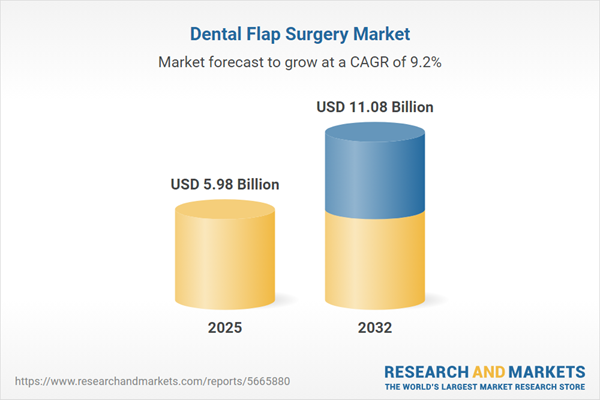Speak directly to the analyst to clarify any post sales queries you may have.
The dental flap surgery market is undergoing significant transformation, driven by evolving clinical practices, emerging technologies, and changing reimbursement and regulatory environments. Senior executives across dental product manufacturing, healthcare delivery, and supply chain management are closely monitoring these trends to safeguard margins and unlock new growth opportunities.
Market Snapshot: Dental Flap Surgery Market Trends and Outlook
The Dental Flap Surgery Market expanded from USD 5.49 billion in 2024 to USD 5.98 billion in 2025 and is set to grow at a CAGR of 9.17%, reaching USD 11.08 billion by 2032. This growth is propelled by increasing demand for minimally invasive surgical solutions, advancements in biomaterials, and broader adoption of digital planning across clinical workflows. As the market adapts to demographic changes, particularly an aging population and rising incidence of periodontal conditions, stakeholders are recalibrating strategies for enhanced quality, cost containment, and value-based healthcare outcomes.
Scope & Segmentation: In-Depth Coverage of the Dental Flap Surgery Market
This comprehensive research analyzes the dental flap surgery market across multiple dimensions:
- Membrane Material: Non-resorbable membranes; resorbable membranes
- Procedure Type: Full thickness flap; papilla preservation flap; partial thickness flap
- End User: Ambulatory centers; dental clinics; hospitals; specialty surgical centers
- Application: Implant site development; ridge augmentation; sinus lift; periodontal regeneration; gingival recession; osseous defect repair; tooth extraction
- Geographic Regions: Americas, including North America (United States, Canada, Mexico) and Latin America (Brazil, Argentina, Chile, Colombia, Peru); Europe, Middle East & Africa (United Kingdom, Germany, France, Russia, Italy, Spain, Netherlands, Sweden, Poland, Switzerland, United Arab Emirates, Saudi Arabia, Qatar, Turkey, Israel, South Africa, Nigeria, Egypt, Kenya); Asia-Pacific (China, India, Japan, Australia, South Korea, Indonesia, Thailand, Malaysia, Singapore, Taiwan)
- Company Analysis: Straumann Holding AG, DENTSPLY SIRONA Inc., Envista Holdings Corporation, Zimmer Biomet Holdings, Inc., Henry Schein, Inc., Danaher Corporation, 3M Company, GC Corporation, Kuraray Co., Ltd., Coltene Holding AG
Key Takeaways for Decision-Makers
- Adoption of minimally invasive flap techniques and patient-centric innovations is accelerating, shaping both clinical practice and procurement trends in dental platforms.
- Rapid integration of digital surgical planning, bioactive membranes, and advanced imaging solutions is redefining the competitive landscape and operational benchmarks.
- Supply chain disruption, particularly in response to geopolitical and tariff measures, has highlighted supply chain resilience, dual sourcing, and localized manufacturing as essential strategic imperatives.
- Hospitals and specialty clinics increasingly favor integrated clinical platforms that combine advanced biomaterials with digital tools, influencing vendor partnerships and procurement frameworks.
- Segment differentiation, from implant site development to periodontal regeneration and tooth extraction, is driving targeted R&D, specialized distribution models, and customized clinician education initiatives.
Tariff Impact on Global Distribution and Costs
Recent tariff implementations in the United States have reshaped global dental surgical supply chains. This has led manufacturers to reassess sourcing, accelerate domestic capacity, and forge new partnerships. Clinical providers are adapting procurement strategies by renegotiating contracts, substituting imported products, or partially absorbing additional costs to maintain patient loyalty and service levels.
Methodology & Data Sources
This research is grounded in a mixed-methods approach. It draws on interviews with key opinion leaders, procurement officers, and regulatory specialists, coupled with secondary analysis from peer-reviewed literature, regulatory filings, and company reports. Rigorous validation procedures underpin the integrity and neutrality of market insights provided.
Why This Report Matters
- Enables strategic planning through granular analysis of product segments, region-specific growth drivers, and evolving end-user demand in the dental flap surgery market.
- Supports risk mitigation and opportunity identification by detailing the impact of supply chain realignments, technology adoption, and regulatory developments across major geographies.
- Equips business leaders to benchmark against key competitors and refine collaboration and investment strategies for sustainable differentiation.
Conclusion
Sustained innovation and cross-disciplinary collaboration are redefining standards in dental flap surgery. This report provides senior executives with a holistic, actionable view, supporting informed investment, partnership, and growth decisions in a fast-evolving global landscape.
Additional Product Information:
- Purchase of this report includes 1 year online access with quarterly updates.
- This report can be updated on request. Please contact our Customer Experience team using the Ask a Question widget on our website.
Table of Contents
3. Executive Summary
4. Market Overview
7. Cumulative Impact of Artificial Intelligence 2025
Companies Mentioned
The companies profiled in this Dental Flap Surgery market report include:- Straumann Holding AG
- DENTSPLY SIRONA Inc.
- Envista Holdings Corporation
- Zimmer Biomet Holdings, Inc.
- Henry Schein, Inc.
- Danaher Corporation
- 3M Company
- GC Corporation
- Kuraray Co., Ltd.
- Coltene Holding AG
Table Information
| Report Attribute | Details |
|---|---|
| No. of Pages | 194 |
| Published | October 2025 |
| Forecast Period | 2025 - 2032 |
| Estimated Market Value ( USD | $ 5.98 Billion |
| Forecasted Market Value ( USD | $ 11.08 Billion |
| Compound Annual Growth Rate | 9.1% |
| Regions Covered | Global |
| No. of Companies Mentioned | 11 |









